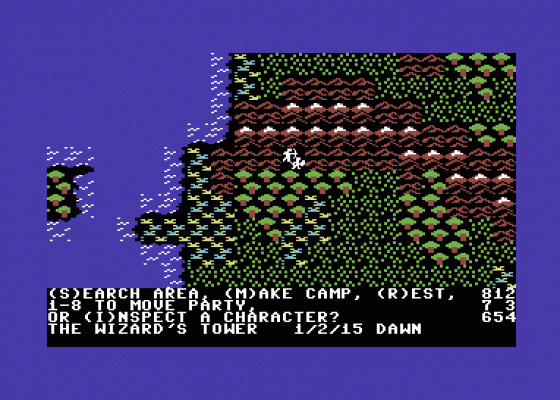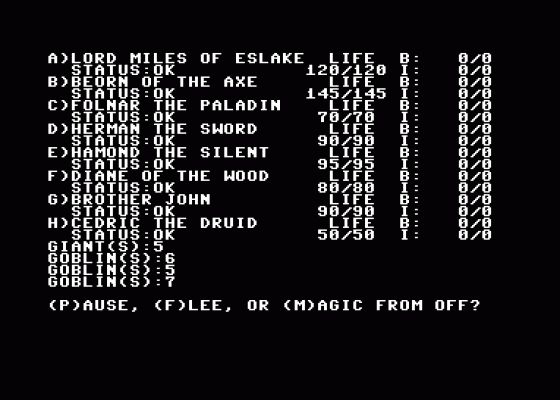
Zzap
 1st April 1988
1st April 1988
Categories: Review: Software
Publisher: Strategic Simulations Inc
Machine: Commodore 64/128
Published in Zzap #36
The Eternal Dagger
This is the first review in a series in which I'll take a look at some past releases which I haven't had the chance to review in Manoeuvres. SSI have a huge back catalogue of games which are readily available - by mail order, at least, and probably through friendly software shops - only a fraction of which have ever been covered in Zzap! Having finally got hold of some of them, and having no new releases to review this month, I've decided to start with one of SSI's fantasy strategy role-playing games, The Eternal Dagger.
This, apparently, is the sequel to The Wizard's Crown, a game which I have not seen. It is, however, entirely self-contained - you can use characters saved from a previous game of Wizard's Crown, although you have to leave behind all their goodies, but the story bears only a tacked-on relation to its prequel and there are full character generation facilities.
The player controls a party of adventurers who are native to the land of Arghan, which he had the task of saving in the previous game. It comes as no great surprise to the seasoned hero to learn that it is in desperate danger yet again, under attack be hordes of screaming undead nasties flowing in from the Dungeon Dimension. The source of these undesirables was unknown to the Wizard's Fellowship until its leader made contact with a wizard, Ssur, in the Middle World.

The Middle World is not geographically separate from Arghan; rather, it appears to be in a slightly different dimension, and travel there requires adventurers to pass through a 'gate', leaving behind all weapons and armour and magic items. Ssur is the last surviving wizard in the Middle World. The others have all been defeated by the Big Bad Evil Necromancer, who is leading an invasion of unpleasant forces, using the Middle World as a beach-head, he is planning to move into Arghan.
The battle for the Middle World has not quite been lost as yet - Ssur and a few rebels still hold out - but once it has, there is no hope for Arghan. Until the next game. The response of the Arghan Wizard's Fellowship is the obvious one. Send a few decent skull-splitting chaps into the Middle World to wander about the landscape in a party killing monsters, looting their treasure, finding magic items in dungeons...
Attentive readers might well conclude that this sounds very much like Shard Of Spring, and indeed every other computer roleplaying game they have ever encountered. And so it is, unashamedly. It does not have a readily apparent quest object, although I suspect that one might be discovered in the course of adventuring; the general idea is merely to bump off a few of the nasties, and delay the wholesale invasion of Arghan while the Wizard's Fellowship builds up its forces.

I note with interest that the SSI catalogue describes Shard Of Spring as 'introductory' and The Eternal Dagger as 'intermediate'. This seems reasonable for the game system of The Eternal Dagger, although it bears a generic resemblance to that of Shard Of Spring, is quite a bit more complex. There's more of everything; more weapons, more armour, more combat damage rules, more character types and more skills.
Unless you want to use the thoughtfully-provided pre-generated party, creating a set of characters is the next stage. The party can contain up to eight, and as usual there is little advantage in going out with less than the maximum number.
The player has complete control over the creation of a character, there being no random element involved. Each has a fairly standard set of characteristics - intelligence, strength, dexterity and hit points - which are bought up to any level the player desires from a pool of 58 points. Intelligence is determined not by point expenditure but by the choice of profession, and professions must be bought with points from the pool.

It costs 14 points to become a sorcerer, 2 to become a ranger and intelligence - roughly related to the cost - the professions allow a basic, automatic aptitude in the range of skills associated with them. It is possible for characters to have more than one profession - there's nothing to stop them having all five - and it is expected that many will, for the skills associated with being a thief are essential, but a character who was nothing but a thief would be very little use for anything other than picking locks.
As a final touch, the player can choose a figure to represent each character from a bank of about thirty in slightly different poses, wielding different weapons. This reminded me of choosing lead figures in live role-playing, and making desperate efforts of imagination to convince each other that a nicely painted half orc really did look a bit like a female magic user.
This character generation sequence is very scientific, slightly confusing, and seems to me to lack excitement. In a strange way it's too generous, and through its desire to allow for the sophistication of multi-profession characters it loses their individuality. Although blindly rolling for characteristics is an old-fashioned way of doing things, most modern live role-playing systems retain a prominent random element. Being in total control of the composition of the character's abilities may seem sensible, but there's something missing.
The characters start off in Ssur's tower, where the gate between Arghan and the Middle World operates. There they are equipped with their main weapon and - generously - the best kind of armour that they can wear. After choosing one of the part to be a 'pointman', they can set off into the hostile environment of Ssur's island. It has been overrun by the Necromancer, who himself is hiding on a small island off the northwest coast, and so is teeming with undead creatures. The booklet of hints and strategies goes into detail about the environs, and points the way to the first scenario. A large dragon roaming about part of the island was responsible for stealing Ssur's secret weapon, the Holy Morning Star, which ensured that the Necromancer was able to overpower him. A brand of rebels hiding in the north have a special dragon-slaying sword, and if the party can make contact with them they might be able to recover the Holy Morning Star from the dragon's lair.
A symbolic representation of the party moves about a landscape of hills, grass, swamp and plains, while time passes only with each player move. This aspect of the game is similar to Shard Of Spring. Surprise random encounters happen too with wearisome regularity. But there is a remedy for this: instead of being forced to act out every encounter in detail, you can choose between 'quick' and 'tactical' combat. Quick combat resolves the battle immediately, without going into any details, and is only to be used when you're certain that your party can walk over the opposition. It gives the opposition a much better chance of winning.
Tactical combat plays everything out in detail. However, unless the party is ambushed, you do usually have the option to attempt to establish friendly relations with any group encountered. Often it's essential to talk rather than fight.
Tactical combat is complex and involved, without really being involving. Each character has a wide variety of possible moves to make in his action phase; as well as the obvious option of attacking a nearby enemy, he can do things like 'sneak' - try to hide from the enemy - and 'stand on guard'. Some can be combined with physical movement, but others take up the whole action phase. Naturally, magic users have access to a battery of offensive magic, and the kind of tasks that can be performed in battle by sorcerers vary from straightforward fireballing to turning the whole party invisible. Priests can pray, too, to effect instant healing.
When a character is hit, a description of the wound, its location of the body, and its effect is flashed onto the screen. A distinction is made between injury and bleeding, and characters can die from blood loss with alarming rapidity. It is not easy to tell what state the opponents are in.
It was my experience that - even playing on the easiest level, and there are five - as soon as my party set foot beyond Ssur's tower they were met by large hordes of monsters who just outclassed them and certainly outnumbered them. The tactical combat is slow - it doesn't have the satisfying simplistic smoothness of the routine in Shard Of Spring - and the sheer number of enemies in the wilderness encounters make it seem interminable.
When at long last the opponents have been defeated, the party can stuff their weapons and possessions into their backpacks and when they get to a town can sell them to make the neessary money to buy enchanted weapons and armour.
There is a lot of depth in this game, a lot of detail, and a lot of imaginatively-conceived islands to map. But it's something that you will have to approach in a serious and business-like frame of mind, armed with mapping paper and a notepad and a free stretch of about eight hours.
If you like computer role-playing games, this will give you something solid to get your teeth into, but if you want a gentler introduction I would recommend you try Shard Of Spring first.
Verdict
Presentation 70%
Control is entirely via the keyboard; with no joystick option, movement is awkward.
Graphics 61%
Not very inspiring, and it's sometimes difficult to tell what's what.
Rules 90%
Well laid out and detailed, giving charts for all statistical rules, and a background book provide atmosphere.
Playability 72%
Tactical combat is drawn-out and occurs too often in the wilderness, but the storyline has its own pull.
Overall 86%
A solid and complex game example of this specialised genre, which certainly has a lot of play in it.



